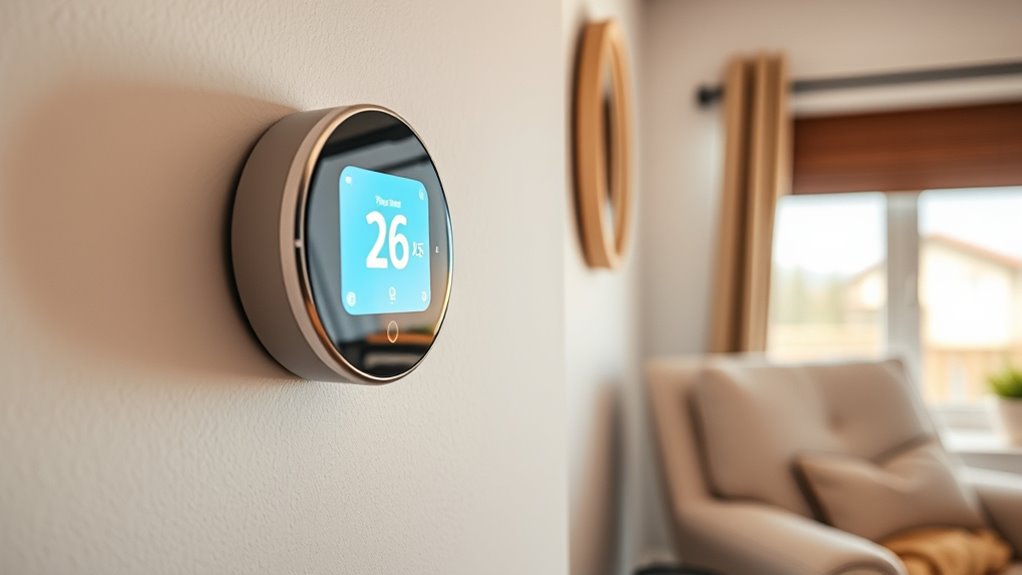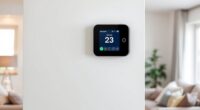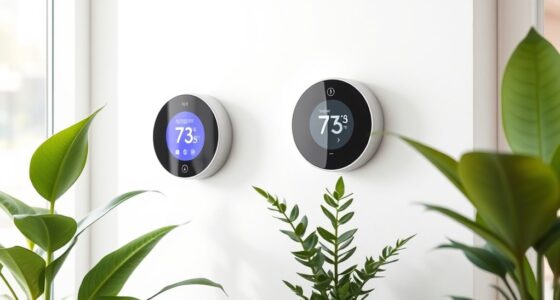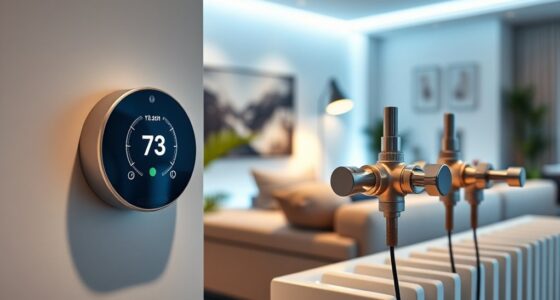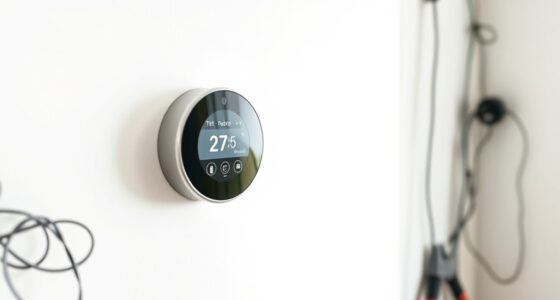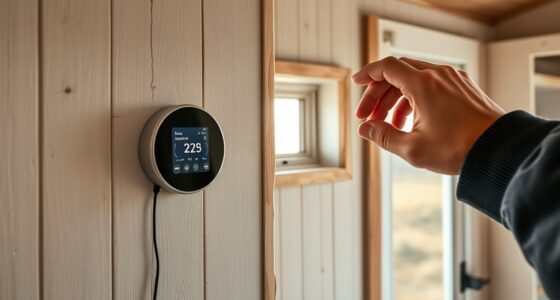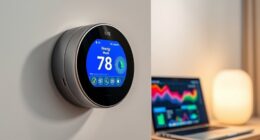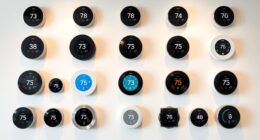To calibrate your smart thermostat sensors, start by placing a reliable digital thermometer and your thermostat sensor together away from heat sources. Wait for both readings to stabilize, then compare their temperatures. If needed, access your thermostat’s calibration settings through the app or interface and adjust the sensor to match the reference thermometer. Regular calibration guarantees accuracy and energy efficiency, and if you want to learn more about fine-tuning your system, just keep exploring further steps.
Key Takeaways
- Use a reliable digital thermometer to compare sensor readings with actual room temperature.
- Access your thermostat’s calibration settings via the app or device interface.
- Place the reference thermometer and thermostat sensor away from heat sources for accurate comparison.
- Adjust the sensor calibration to match the reference thermometer, following manufacturer instructions.
- Regularly verify sensor accuracy and recalibrate as needed to maintain optimal system performance.
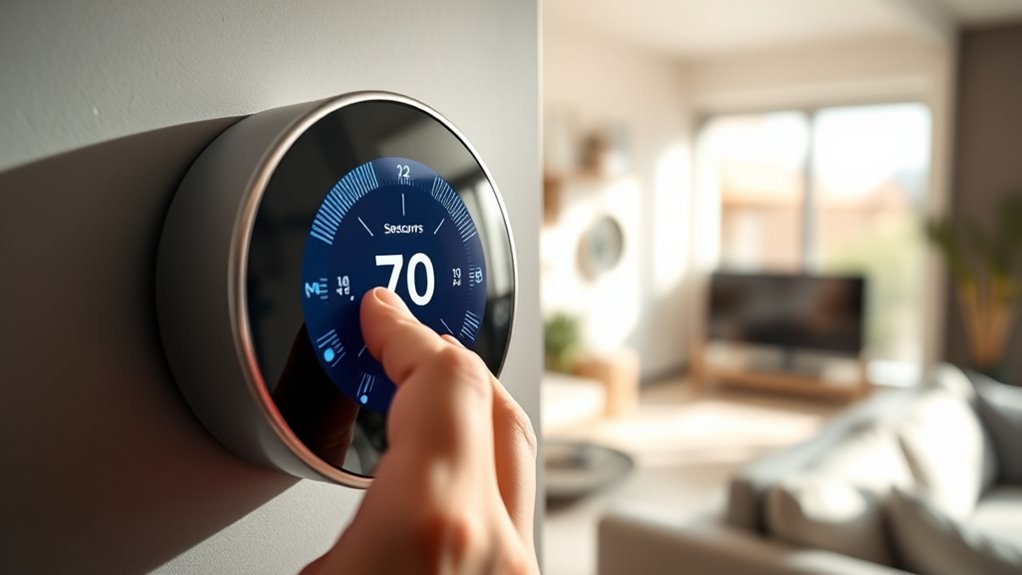
Calibrating your smart thermostat guarantees it accurately maintains your desired temperature, saving you energy and money. When your thermostat’s sensors are precise, your heating and cooling systems respond correctly, preventing wasteful energy use and ensuring comfort. Over time, sensors can drift from their original calibration, leading to inaccurate temperature readings. That’s why regular calibration is vital. To do this effectively, you need to understand sensor accuracy and utilize appropriate calibration tools. Sensor accuracy refers to how closely your thermostat’s sensors measure the actual room temperature. If your thermostat reads a different temperature than what’s truly in the room, it may turn your HVAC system on or off prematurely or too late, compromising comfort and efficiency. Calibration tools, which vary depending on your model, help you adjust the sensor so it reflects the real temperature more accurately. Arcade machine technologies have evolved to include smart sensors that can assist with calibration processes, ensuring more precise temperature control. Additionally, some models incorporate automated calibration features that simplify this process for users. Start by checking your thermostat’s current accuracy. Use a reliable, independent thermometer—preferably a digital one with a known high accuracy—as a reference. Place it alongside your thermostat sensor in the same room, ideally away from direct sunlight, drafts, or heat sources that could skew readings. Wait a few minutes for the thermometer to stabilize, then compare the readings. If you notice discrepancies—say, your thermostat shows 72°F while the thermometer registers 70°F—you’ll need to calibrate the sensor. Most smart thermostats have built-in calibration options accessible through their app or interface. If your device supports calibration tools, navigate to the settings menu and look for an option labeled “sensor calibration” or similar. Follow the instructions carefully, which typically involve adjusting the sensor reading until it aligns with your reference thermometer. If your thermostat lacks such features, you may need to manually adjust the system’s temperature settings or consider a firmware update that may include calibration improvements. Some advanced models allow for more precise calibration using external calibration tools or software. For example, you might connect a calibration device that provides a known temperature input, allowing you to fine-tune the sensor’s accuracy. It’s vital to follow the manufacturer’s guidelines during this process to avoid overcompensation, which could lead to new inaccuracies. Proper calibration also involves understanding the sensor accuracy specifications provided by your device’s manufacturer. Once calibrated, monitor the readings over several hours or days to ensure the sensor consistently reflects the actual room temperature. Proper calibration ensures your smart thermostat responds correctly, optimizing comfort and reducing unnecessary energy consumption. Regularly verifying sensor accuracy with calibration tools keeps your system functioning at its best, saving you money and extending the lifespan of your HVAC equipment.
Frequently Asked Questions
How Often Should I Calibrate My Thermostat Sensors?
You might wonder how often you should calibrate your thermostat sensors. To maintain sensor accuracy, it’s best to check calibration every six months or if you notice inconsistent temperature readings. Regular calibration ensures your smart thermostat responds correctly, saving energy and enhancing comfort. Keep an eye on sensor performance and adjust calibration frequency as needed, especially if you experience temperature discrepancies or seasonal changes affecting sensor accuracy.
Can I Calibrate Sensors Remotely or Only Manually?
You can often perform remote calibration to improve sensor accuracy without needing to manually adjust your smart thermostat. Many devices offer app-based options or online tools for remote calibration, making it convenient to fine-tune your sensors from anywhere. Check your thermostat’s settings or manufacturer’s instructions to see if remote calibration is available. This way, you guarantee your sensors stay accurate and your home stays comfortable.
What Signs Indicate My Sensors Need Recalibration?
Imagine your thermostat says it’s 72°F, but your room feels much cooler—your sensors might need recalibration. Signs include inconsistent temperature readings, frequent system cycling, or noticeable comfort issues. These clues indicate sensor accuracy problems. Using simple calibration methods, you can improve performance. Regularly checking for these signs helps ensure your smart thermostat maintains accurate temperature control, keeping your home comfortable and energy-efficient.
Does Calibration Affect My Thermostat’s Energy Efficiency?
Calibration definitely impacts your thermostat’s energy efficiency by improving sensor accuracy. When sensors are properly calibrated using effective calibration methods, they can more accurately detect temperature changes, preventing unnecessary heating or cooling. This means your system runs only when needed, saving energy and lowering utility bills. So, regular calibration ensures your thermostat responds correctly, optimizing comfort and efficiency. Keep in mind, well-maintained sensors make a noticeable difference in overall system performance.
Are There Specific Tools Required for Sensor Calibration?
Ever notice how sometimes your thermostat seems a bit off? To improve sensor accuracy, you might wonder if specific calibration tools are necessary. In most cases, simple tools like a smartphone thermometer app or a temperature probe can help you check sensor readings. These calibration tools guarantee your thermostat maintains accurate sensor performance, so your home stays comfortable and energy-efficient. You don’t always need fancy equipment—sometimes, everyday tools do the trick!
Conclusion
calibrating your smart thermostat sensors guarantees accurate temperature readings, helping you save energy and stay comfortable. Did you know that improperly calibrated thermostats can increase energy bills by up to 15%? By taking a few minutes to calibrate your sensors, you not only boost your home’s efficiency but also reduce costs. Stay proactive with your smart device, and enjoy consistent comfort all year round. Remember, a small effort can lead to big savings!
